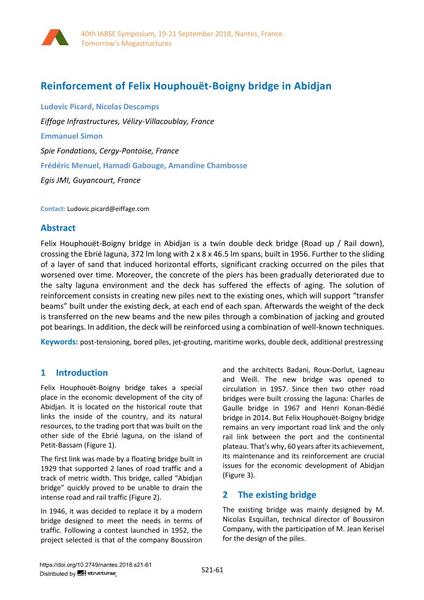Reinforcement of Felix Houphouët-Boigny bridge in Abidjan

|
|
|||||||||||
Bibliografische Angaben
| Autor(en): |
Ludovic Picard
(Eiffage Infrastructures, Vélizy-Villacoublay, France)
Nicolas Descamps (Eiffage Infrastructures, Vélizy-Villacoublay, France) Emmanuel Simon (Spie Fondations, Cergy-Pontoise, France) Frédéric Menuel (Egis JMI, Guyancourt, France) Hamadi Gabouge (Egis JMI, Guyancourt, France) Amandine Chambosse (Egis JMI, Guyancourt, France) |
||||
|---|---|---|---|---|---|
| Medium: | Tagungsbeitrag | ||||
| Sprache(n): | Englisch | ||||
| Tagung: | IABSE Symposium: Tomorrow’s Megastructures, Nantes, France, 19-21 September 2018 | ||||
| Veröffentlicht in: | IABSE Symposium Nantes 2018 | ||||
|
|||||
| Seite(n): | S21-61 | ||||
| Anzahl der Seiten (im PDF): | 10 | ||||
| DOI: | 10.2749/nantes.2018.s21-61 | ||||
| Abstrakt: |
Felix Houphouët-Boigny bridge in Abidjan is a twin double deck bridge (Road up / Rail down), crossing the Ebrié laguna, 372 lm long with 2 x 8 x 46.5 lm spans, built in 1956. Further to the sliding of a layer of sand that induced horizontal efforts, significant cracking occurred on the piles that worsened over time. Moreover, the concrete of the piers has been gradually deteriorated due to the salty laguna environment and the deck has suffered the effects of aging. The solution of reinforcement consists in creating new piles next to the existing ones, which will support “transfer beams” built under the existing deck, at each end of each span. Afterwards the weight of the deck is transferred on the new beams and the new piles through a combination of jacking and grouted pot bearings. In addition, the deck will be reinforced using a combination of well-known techniques. |
||||
| Stichwörter: |
Bohrpfähle
|
||||
